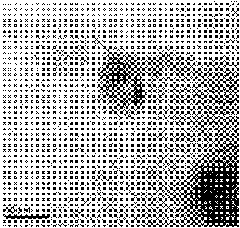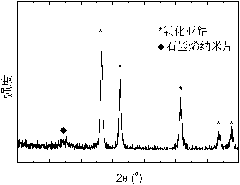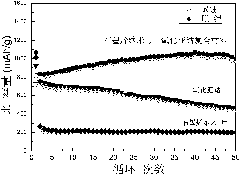Graphene nanometer sheet-cobaltous oxide composite negative electrode material of lithium ion battery and preparation method thereof
A graphene nanosheet, lithium ion battery technology, applied in battery electrodes, cobalt oxide/cobalt hydroxide, non-aqueous electrolyte battery electrodes, etc., can solve the problems of low charge and discharge current, poor initial efficiency and cycle performance, etc. The effect of improving the contact area, excellent cycle performance and stable performance
- Summary
- Abstract
- Description
- Claims
- Application Information
AI Technical Summary
Problems solved by technology
Method used
Image
Examples
Embodiment 1
[0023] Disperse 0.5 g of graphite oxide in 400 ml of aqueous solution, ultrasonic time is 6 hours, add 2.79 g of cobalt acetate tetrahydrate, 10 ml of hydrazine hydrate, and 15 ml of ammonia water, stir and pour into a hydrothermal kettle, seal it, and heat it at 150 degrees Celsius After reacting for 5 hours, filter, wash, and dry to obtain a graphite oxide-cobalt hydroxide composite material, and treat the prepared composite at 500 degrees Celsius for 2 hours under the protection of argon to obtain graphene nanosheets-cobaltous oxide Composite negative electrode material, wherein the weight percentage of graphene nanosheets is 18.5%. figure 1 It is a transmission electron microscope image of the prepared graphene nanosheet cobaltous oxide negative electrode material. It can be clearly seen that the graphene nanosheets are interlacedly distributed on the surface of the cobaltous oxide particle. figure 2 The X-ray diffraction spectrum of the graphene nanosheet-cobaltous oxide...
Embodiment 2
[0025] Disperse 0.5 g of graphite oxide in 300 ml of isopropanol-water solution (volume ratio of 1:10), stir at room temperature for 6 hours, add 3.26 g of cobalt nitrate hexahydrate, 15 ml of ammonia, 0.08 g of sodium borohydride, and stir Pour it into a hydrothermal kettle, seal it, and react at 120 degrees Celsius for 5 hours, then filter, wash, and dry to obtain a graphite oxide-cobalt hydroxide composite material, which is treated at 300 degrees Celsius for 2 hours under nitrogen protection to obtain graphite Graphene nanosheet-cobaltous oxide composite negative electrode material, wherein the weight percentage of graphene nanosheet is 20.1%. The reversible specific capacity of the charge-discharge test at a current density of 200mA / g is 840mAh / g.
Embodiment 3
[0027] Disperse 0.5 grams of graphite oxide in 300 ml of isopropanol-water solution (volume ratio is 1:15), ultrasonic time is 2 hours, add 3.26 grams of cobalt sulfate heptahydrate, 15 milliliters of ammonia water, 0.1 grams of ascorbic acid, pour into water after stirring In a hot kettle, sealed, and reacted at 200 degrees Celsius for 10 hours, filtered, washed, and dried to obtain graphite oxide cobalt hydroxide materials, which were treated at 600 degrees Celsius for 2 hours under nitrogen protection to obtain graphene nanosheets-oxidized Sub-cobalt composite negative electrode material, wherein the weight percentage of graphene nanosheets is 17.8%. The reversible specific capacity of the charge-discharge test at a current density of 200mA / g is 930mAh / g.
PUM
 Login to View More
Login to View More Abstract
Description
Claims
Application Information
 Login to View More
Login to View More - R&D
- Intellectual Property
- Life Sciences
- Materials
- Tech Scout
- Unparalleled Data Quality
- Higher Quality Content
- 60% Fewer Hallucinations
Browse by: Latest US Patents, China's latest patents, Technical Efficacy Thesaurus, Application Domain, Technology Topic, Popular Technical Reports.
© 2025 PatSnap. All rights reserved.Legal|Privacy policy|Modern Slavery Act Transparency Statement|Sitemap|About US| Contact US: help@patsnap.com



